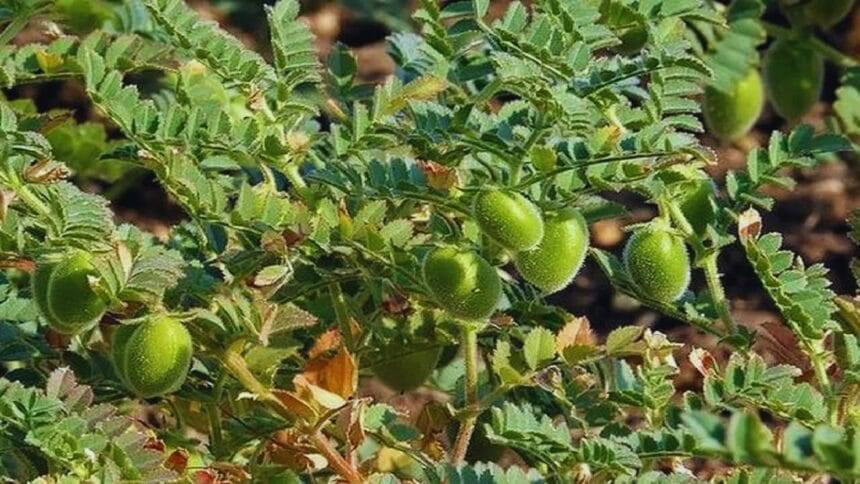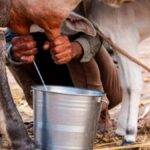Main Points In Hindi (मुख्य बातें – हिंदी में)
-
ग्राम फसल की बुवाई का सही समय: रबी के सीजन में ग्राम की बुवाई के लिए 15 दिसंबर तक का समय महत्वपूर्ण है। यदि बुवाई में देरी होती है, तो उत्पादन में भारी कमी आ सकती है। अक्टूबर का पहला सप्ताह बुवाई के लिए सबसे अच्छा है, और बिना सिंचाई वाले क्षेत्रों में इसे दूसरे सप्ताह तक करना चाहिए।
-
उखथा रोग का खतरा: यदि किसान समय पर बुवाई नहीं करते हैं या बीज का उपचार नहीं करते हैं, तो उनके फसल रोगों और कीटों के हमले का शिकार हो सकती हैं। उखथा रोग एक गंभीर बीमारी है, जो पूरी खेत में फैल सकती है और अगर समय पर रोक नहीं लगाई गई, तो यह पूरी फसल को नष्ट कर सकती है।
-
बीज का उपचार: उखथा रोग से बचाव के लिए बीजों का उचित उपचार महत्वपूर्ण है। बीजों को कार्बेन्डाजिम या अन्य एंटीफंगल पदार्थों से उपचारित किया जाना चाहिए, ताकि रोग का बुरा प्रभाव फसल पर न पड़े। बुवाई अक्टूबर के अंत या नवंबर के पहले सप्ताह में की जानी चाहिए।
-
रोग की पहचान और उपाय: जब उखथा रोग के लक्षण फसल में दिखाई दें, तो फ fungicide का सही तरीके से उपयोग करके उसका इलाज किया जाना चाहिए। इसके लिए पौधों की जड़ों पर करबेंडाज़िम का 0.2 प्रतिशत समाधान छिड़कने से रोग का असर कम किया जा सकता है।
- सही किस्मों का चयन: उखथा रोग से प्रभावित नहीं होने वाली नई किस्मों का चयन करना चाहिए, जैसे Pusa-372, JG 11, और अन्य स्थानीय किस्में, ताकि फसल की सुरक्षा सुनिश्चित की जा सके।
Main Points In English(मुख्य बातें – अंग्रेज़ी में)
Here are the main points summarized from the provided text:
-
Optimal Sowing Time: The ideal time for sowing Rabi pulse crop gram is by December 15, with a recommendation for the first week of October in irrigated conditions and by the second week of October in non-irrigated conditions. Delays in sowing can significantly reduce yields and increase the risk of insect infestations.
-
Risk of Ukhatha Disease: Ukhatha disease, caused by the fungus Fusarium oxysporum, poses a severe threat to gram crops. This soil and seed-borne disease can affect plants at any growth stage, causing symptoms such as leaf wilting and eventual plant death.
-
Seed Treatment for Prevention: To combat Ukhatha disease, it is advised to sow treated seeds at the end of October or the first week of November using specific fungicides like Carbendazim or Trichoderma viride, which help prevent the disease’s adverse effects.
-
Management of Disease Symptoms: If symptoms of Ukhatha disease appear in the crop, treatment with fungicides should be applied promptly, particularly targeting the roots to prevent further damage.
- Disease-Resistant Varieties: Certain improved indigenous and Kabuli varieties of gram, such as Pusa-372 and Pusa Miracle, are less susceptible to Ukhatha disease. It is also recommended to avoid cultivating pigeon pea in fields previously infested with the disease for several years to prevent recurrence.


Complete News In Hindi(पूरी खबर – हिंदी में)
इस समय में रबी की दाल वाली फसल चना (ग्राम) बोने का समय है। कृषि विशेषज्ञों के अनुसार, चना की बुवाई 15 दिसंबर तक करनी चाहिए। यदि बुवाई में देरी होती है, तो उपज significantly कम हो सकती है। इसके अलावा, देर से बुवाई करने पर चना के फली खाने वाले कीट का खतरा बढ़ जाता है। इसलिए, अक्टूबर के पहले सप्ताह में चना की बुवाई के लिए सबसे अच्छा समय है। बिना सिंचाई वाले क्षेत्रों में, चना की बुवाई दूसरे सप्ताह तक करनी चाहिए।
हर साल कई किसान किसी न किसी कारण से फसल समय पर नहीं बो पाते हैं या असुरक्षित बीज बोते हैं। ऐसी स्थिति में, उनकी फसल कई तरह की बीमारियों और कीटों के हमले का शिकार होती है। आज हम आपको चना की एक खतरनाक बीमारी के बारे में बताएंगे, जो समय पर रोकथाम न की जाने पर पूरे फसल को नष्ट कर सकती है। इसका नाम उखटा रोग है।
यह बीमारी खेत में फैल सकती है
उखटा रोग मुख्य रूप से चना फसल को नुकसान पहुँचाता है। इस रोग का प्रकोप इतना गंभीर होता है कि पूरा खेत इससे प्रभावित हो जाता है। इस रोग का मुख्य कारण एक फंगस है, जिसे Fusarium oxysporum species Syceri कहते हैं। यह एक मिट्टी और बीज द्वारा फैलने वाला रोग है। यह रोग पौधों में फली बनने से पहले किसी भी चरण में हो सकता है। उखटा रोग के लक्षण पहले खेत के छोटे हिस्सों में दिखते हैं और धीरे-धीरे पूरे खेत में फैल जाते हैं। इस बीमारी में पौधों की पत्तियाँ सूख जाती हैं, जिसके बाद पूरा पौधा मुरझा जाता है। संक्रमित पौधों की जड़ के पास अगर काटा जाए तो एक काली संरचना दिखाई देती है।
बीज उपचार के बाद बोएं
बीमारी से बचाव के लिए, बुवाई अक्टूबर के अंत या नवंबर के पहले सप्ताह में करनी चाहिए। बीजों का उपचार करने के लिए Carbendazim 2.5 ग्राम, Carboxin या 2 ग्राम Thiram या 2 ग्राम Trichoderma viride + 1 ग्राम प्रति किलो का उपयोग करें। ऐसा करने से बीमारी का फसल पर कोई बुरा प्रभाव नहीं पड़ेगा।
और पढ़ें – यह पिल्ला दाल की फसलों की तने को खाता है, बचाव के लिए समाधान जानें
बीमारी की स्थिति में ये उपाय करें
जब फसल में ब्लाइट रोग शुरू हो जाए, तो फंगिसाइड का उपयोग करते समय उचित मिश्रण और सुरक्षा उपाय करना चाहिए। फसल में सड़न से बचने के लिए, रोग के लक्षण दिखाई देते ही, पौधों की जड़ों पर Carbendazim 50 WP 0.2 प्रतिशत समाधान छिड़कें।
ये किस्में रिकेट्सियल बीमारी से प्रभावित नहीं होतीं
उन्नत स्वदेशी किस्में जैसे Pusa-372, JG 11, JG 12, JG 16, JG 63, JG 74, JG 130, JG 32, RSG 888, RSG 896, DCP-92-3, हरियाणा चना-1, GNG 663 और उन्नत कबुली किस्में जैसे Pusa Miracle, जावाहर कबुली का चयन जैसे चना-1, विजय, फुले G-95311, JGK 1, JGK 2, JGK 3 आदि।
उखटा रोग कई दालों की फसलों में होता है। कृषि वैज्ञानिकों के अनुसार, उखा रोग फैलने वाले खेत में कुछ वर्षों तक तिल की खेती नहीं करनी चाहिए।
Complete News In English(पूरी खबर – अंग्रेज़ी में)
The time of sowing of Rabi pulse crop gram is going on. According to agricultural experts, sowing of gram crop should be done by 15th December. If there is a delay in sowing, the yield can reduce to a great extent. Besides, due to late sowing, there is a high risk of gram pod borer insect. Therefore, the first week of October is the best week for sowing gram crop. In non-irrigated conditions, gram should be sown by the second week of October.
Every year there are a large number of farmers who, due to some reason, are not able to sow the crop on time or sow the seeds without treatment. In such a situation, their crops are at risk of attack by many types of diseases and pests. Today we are going to tell you about one such dangerous disease of gram crop, which if not prevented on time, can destroy the entire crop. Its name is Ukhatha disease.
The disease can spread throughout the field
Ukhatha disease mainly damages gram crop. The outbreak of this disease is so terrible that the entire farm gets affected by it. The main cause of this disease is a fungus called Fusarium oxysporum species Syceri. This is a soil and seed borne disease. This disease can occur at any stage in the plant until pods appear. Symptoms of Ukhatha disease initially appear in small parts of the field and gradually spread to the entire field. In this disease, the leaves of the plant dry up, after which the entire plant withers and dries up. When an incision is made near the root of the infested plant, a black structure is visible.
Sow after seed treatment
To prevent the disease, sowing should be done in the end of October or the first week of November. Carbendazim 2.5 gm or Carboxin or + 2 gm Thiram or 2 gm Trichoderma viride + 1 gm/kg. Treat seeds as per seed rate. By doing this the disease will not have any bad effect on the crop.
Also read – This puppy eats the stalks of pulse crops, know the solution for prevention
Do these measures in case of illness
When the blight disease starts in the crop, proper mixing and safety measures should be taken while using fungicides. To prevent rot in the crop, sprinkle Carbendazim 50 WP 0.2 percent solution on the roots of the plants when symptoms of the disease appear.
These varieties do not suffer from rickettsial disease
Improved indigenous varieties like Pusa-372, JG 11, JG 12, JG 16, JG 63, JG 74, JG 130, JG 32, RSG 888, RSG 896, DCP-92-3, Haryana Chana-1, GNG 663 and Improved Kabuli varieties like Pusa Miracle, Jawahar Kabuli Select anti-sickness like Chana-1, Vijay, Phule G-95311, JGK 1, JGK 2, JGK 3 etc.
Ukhatha disease occurs in many pulse crops. According to agricultural scientists, pigeon pea should not be cultivated for a few years in a field where Ukha disease has spread.




